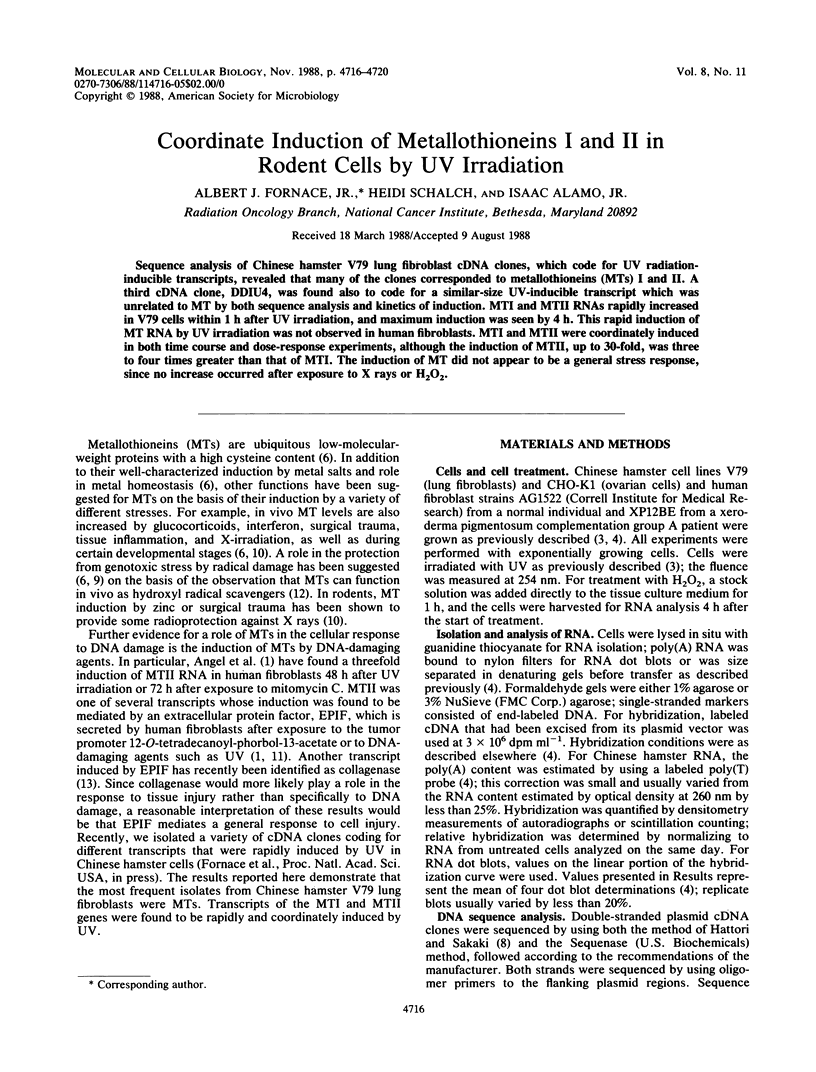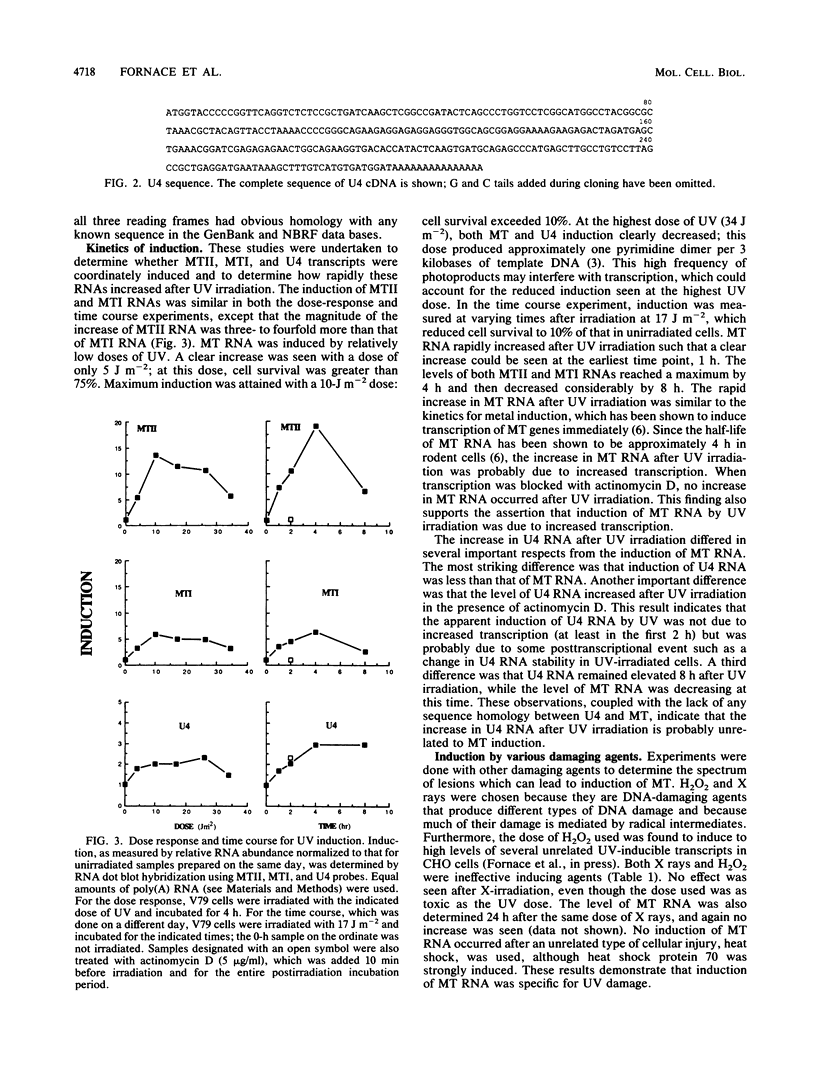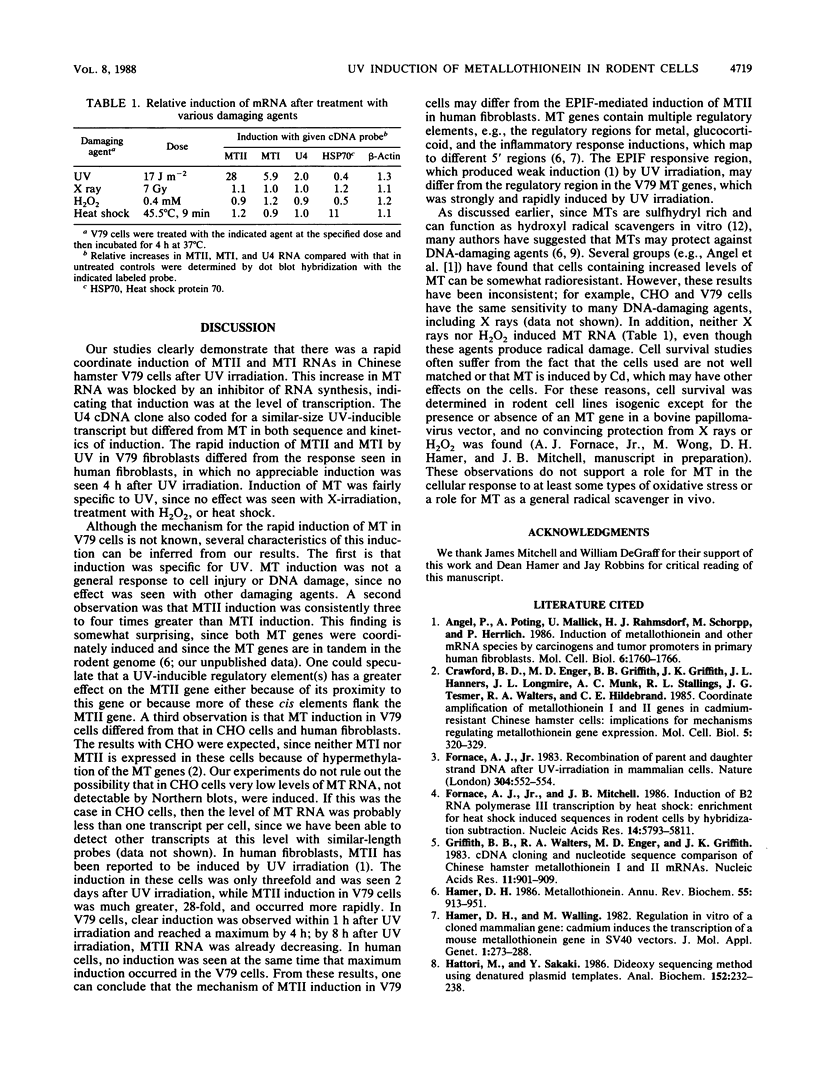Abstract
Sequence analysis of Chinese hamster V79 lung fibroblast cDNA clones, which code for UV radiation-inducible transcripts, revealed that many of the clones corresponded to metallothioneins (MTs) I and II. A third cDNA clone, DDIU4, was found also to code for a similar-size UV-inducible transcript which was unrelated to MT by both sequence analysis and kinetics of induction. MTI and MTII RNAs rapidly increased in V79 cells within 1 h after UV irradiation, and maximum induction was seen by 4 h. This rapid induction of MT RNA by UV irradiation was not observed in human fibroblasts. MTI and MTII were coordinately induced in both time course and dose-response experiments, although the induction of MTII, up to 30-fold, was three to four times greater than that of MTI. The induction of MT did not appear to be a general stress response, since no increase occurred after exposure to X rays or H2O2.
Full text
PDF




Images in this article
Selected References
These references are in PubMed. This may not be the complete list of references from this article.
- Angel P., Pöting A., Mallick U., Rahmsdorf H. J., Schorpp M., Herrlich P. Induction of metallothionein and other mRNA species by carcinogens and tumor promoters in primary human skin fibroblasts. Mol Cell Biol. 1986 May;6(5):1760–1766. doi: 10.1128/mcb.6.5.1760. [DOI] [PMC free article] [PubMed] [Google Scholar]
- Crawford B. D., Enger M. D., Griffith B. B., Griffith J. K., Hanners J. L., Longmire J. L., Munk A. C., Stallings R. L., Tesmer J. G., Walters R. A. Coordinate amplification of metallothionein I and II genes in cadmium-resistant Chinese hamster cells: implications for mechanisms regulating metallothionein gene expression. Mol Cell Biol. 1985 Feb;5(2):320–329. doi: 10.1128/mcb.5.2.320. [DOI] [PMC free article] [PubMed] [Google Scholar]
- Fornace A. J., Jr, Mitchell J. B. Induction of B2 RNA polymerase III transcription by heat shock: enrichment for heat shock induced sequences in rodent cells by hybridization subtraction. Nucleic Acids Res. 1986 Jul 25;14(14):5793–5811. doi: 10.1093/nar/14.14.5793. [DOI] [PMC free article] [PubMed] [Google Scholar]
- Fornace A. J., Jr Recombination of parent and daughter strand DNA after UV-irradiation in mammalian cells. Nature. 1983 Aug 11;304(5926):552–554. doi: 10.1038/304552a0. [DOI] [PubMed] [Google Scholar]
- Griffith B. B., Walters R. A., Enger M. D., Hildebrand C. E., Griffith J. K. cDNA cloning and nucleotide sequence comparison of Chinese hamster metallothionein I and II mRNAs. Nucleic Acids Res. 1983 Feb 11;11(3):901–910. doi: 10.1093/nar/11.3.901. [DOI] [PMC free article] [PubMed] [Google Scholar]
- Hamer D. H. Metallothionein. Annu Rev Biochem. 1986;55:913–951. doi: 10.1146/annurev.bi.55.070186.004405. [DOI] [PubMed] [Google Scholar]
- Hamer D. H., Walling M. Regulation in vivo of a cloned mammalian gene: cadmium induces the transcription of a mouse metallothionein gene in SV40 vectors. J Mol Appl Genet. 1982;1(4):273–288. [PubMed] [Google Scholar]
- Hattori M., Sakaki Y. Dideoxy sequencing method using denatured plasmid templates. Anal Biochem. 1986 Feb 1;152(2):232–238. doi: 10.1016/0003-2697(86)90403-3. [DOI] [PubMed] [Google Scholar]
- Matsubara J., Tajima Y., Karasawa M. Metallothionein induction as a potent means of radiation protection in mice. Radiat Res. 1987 Aug;111(2):267–275. [PubMed] [Google Scholar]
- Schorpp M., Mallick U., Rahmsdorf H. J., Herrlich P. UV-induced extracellular factor from human fibroblasts communicates the UV response to nonirradiated cells. Cell. 1984 Jul;37(3):861–868. doi: 10.1016/0092-8674(84)90421-5. [DOI] [PubMed] [Google Scholar]
- Thornalley P. J., Vasák M. Possible role for metallothionein in protection against radiation-induced oxidative stress. Kinetics and mechanism of its reaction with superoxide and hydroxyl radicals. Biochim Biophys Acta. 1985 Jan 21;827(1):36–44. doi: 10.1016/0167-4838(85)90098-6. [DOI] [PubMed] [Google Scholar]
- Whitham S. E., Murphy G., Angel P., Rahmsdorf H. J., Smith B. J., Lyons A., Harris T. J., Reynolds J. J., Herrlich P., Docherty A. J. Comparison of human stromelysin and collagenase by cloning and sequence analysis. Biochem J. 1986 Dec 15;240(3):913–916. doi: 10.1042/bj2400913. [DOI] [PMC free article] [PubMed] [Google Scholar]
- Whitham S. E., Murphy G., Angel P., Rahmsdorf H. J., Smith B. J., Lyons A., Harris T. J., Reynolds J. J., Herrlich P., Docherty A. J. Comparison of human stromelysin and collagenase by cloning and sequence analysis. Biochem J. 1986 Dec 15;240(3):913–916. doi: 10.1042/bj2400913. [DOI] [PMC free article] [PubMed] [Google Scholar]



